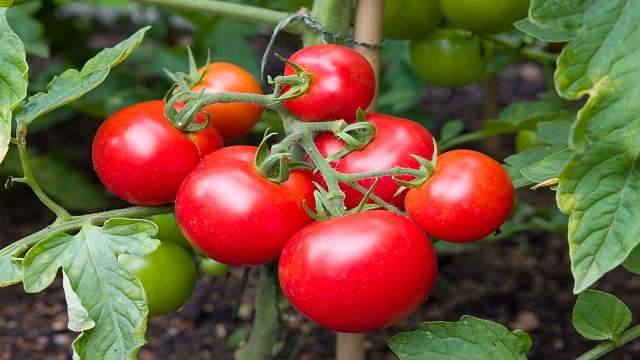The tomato is a fleshy fruit from the northwest of South America. Its culinary importance is well known to all, or could we, perhaps, write the history of the peninsula without gazpacho, salmorejo, or porra antequerana? And, of the Mediterranean, without pizza, tomato with burrata, or cod with tomato? Today we give this protagonist of our kitchens and our gardens the attention it deserves. A tour of its qualities, its origin, types, and recipes, traditional or modern, that enrich our daily lives.
What is tomato
The tomato is the fruit of the Solanum lycopersicum plant, from the Solanaceae family. In countries such as Mexico, it is commonly known as jitomate and the term tomato is reserved for the green variety with skin.
Its fleshy hue is synonymous with summer and the taste of the tomato is a touchstone between sweet, sour, and salty with an earthy edge comparable to the roughness of grapefruit. For many palates, there is a clear distinction between ” the taste of tomatoes from before and those of today “. This categorization is not without reason, and it is without reason because of the juiciness characteristic of a garden tomato. Partly this is because, although the ideal time to plant tomatoes is spring, between March and May, the production and selection of the most resistant tomatoes, as well as the use of greenhouses, has allowed tomatoes to be eaten all year round at the cost of organoleptic loss.
In Spain, Extremadura is leading the way in tomato cultivation, closely followed by Andalusia, while projects such as that of Emilio Medina, a horticulturist who has won two categories at the Torrelavega Tomato Festival, are working to recover dry-land tomatoes with the most intense flavour and without irrigation.
Is tomato a vegetable or a fruit?
Although it may come as a bit of a surprise to us all when we first discover it, the tomato is a fruit, not a vegetable. It appears with the mission of containing, protecting, and helping to spread the seeds of the plant, which is the classic function of fruits. Meanwhile, vegetables are, according to the Spanish Food Code (CAE): “any herbaceous horticultural plant that can be used as food, either raw or cooked” and specifies the difference that vegetables correspond to: “vegetables in which the edible part is made up of their green organs (leaves, stems, inflorescence)”. For that reason, and despite some erroneous definitions that surf the net, the tomato is a fruit and not a vegetable.
Origin and history of the tomato
The origin of the tomato is located in the northwest of South America, in the Andes region of present-day Peru. This is demonstrated by both genetic and phylogenetic studies carried out by authors such as Nikolai Vavilov, a 20th-century Russian researcher and considered the father of modern botany.
According to the author, the tomato spread from the Andes to the north, reaching Mexico where it was cultivated and consumed by the Aztecs. Proof of this is the term “tomato” which finds its etymological root in the word “tomato”, which means “water fruit” in the Nahuatl language, native to the Aztecs of the Mexican highlands.
Due to the importance of the Aztecs in the history of this fruit, many sources claim that they were the first to domesticate the tomato. However, current studies have shown that domestication would have occurred more than 2000 years ago and that it would have occurred simultaneously throughout South America.
As for Spain, the tomato arrived with Columbus’ voyages in the 16th century. From here it spread to the rest of Europe, entering Italy via Naples and Sicily, where the tomato became an essential ingredient in pizzas and pasta. It is hard to believe today that when it first arrived, the tomato was considered little more than an ornamental plant. Today, there are tens of thousands of varieties that can be classified phylogenetically, commercially or according to the uses for which they are intended.
Types of tomatoes
To discover the types of tomatoes that exist, we can use different parameters. If we look at the size of the leaves of the plant, as well as the colour and shape of its fruits, we can use the botanical classification that divides them into: vulgare, cerasiforme, pyriforme, validum, and grandiflorum.
If, on the other hand, we want to emphasize its culinary use, we will talk about the salad tomato, the spreadable tomato, the tomato for sauces, etc. Next, we will focus on its commercial classification that allows us to investigate uses and qualities and makes it easier for us to find the most suitable type of tomato for our purpose in any market or supermarket.
Raf Tomato

The Raf tomato is a good size, characterized by its grooves and the variety of its colors that vary between green and red. It comes from a selection from the Vega de Almería created in search of tomatoes resistant to the fusarium fungus. It is irregular in shape and in cooking it is especially appreciated when eaten raw in slices with oil and salt.
Oxheart tomato
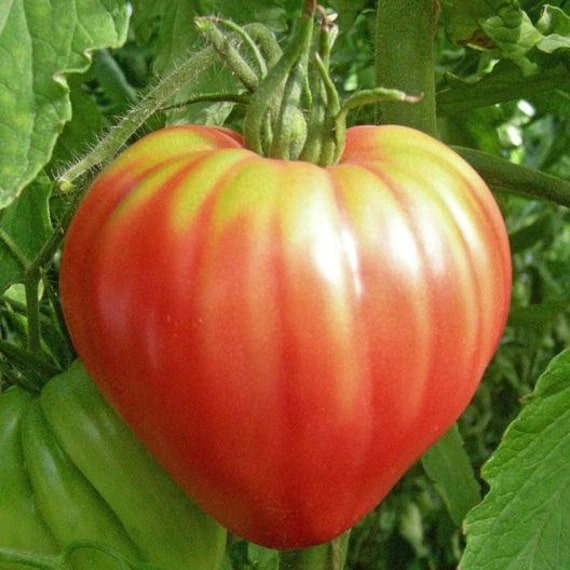
Unlike the Raf tomato, the ox heart tomato has its origins in South America. Although it is similar in its grooves and its large size, it can weigh up to 400 g each. It is also similar in its uses, since due to its tenderness, fleshiness, and flavour it is ideal to eat raw, in salad or in slices. It has a sweet bite and the skin is especially thin compared to other varieties.
Pear Tomato
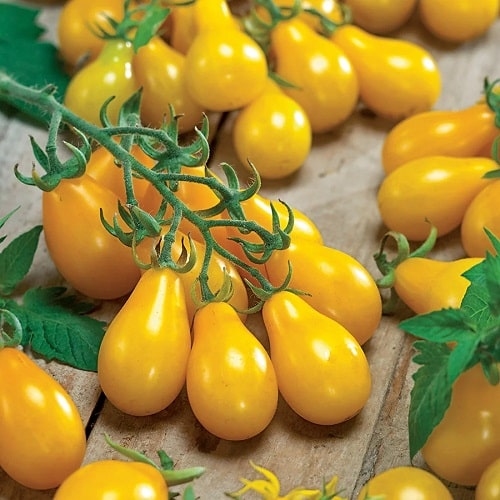
Which tomato to use for gazpacho? The pear tomato is your answer. Whether for gazpacho, salmorejo or for preparing canned tomatoes, this is the right variety. Its name designates its elongated and rounded shape and, in the absence of a vine tomato, this one can also be a great option to consider for spreading tomato on your toast.
Cherry Tomato
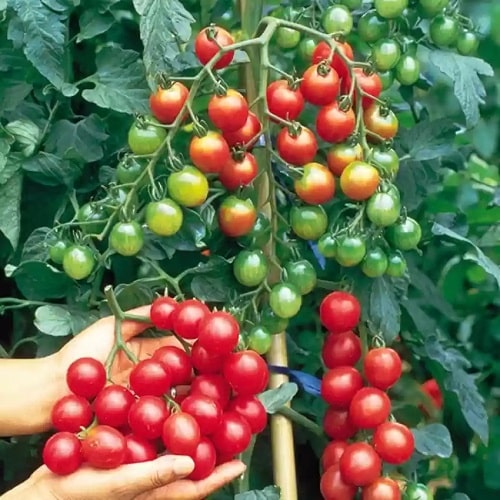
The most famous miniature variety. The plant hosts them in clusters and you can find red, yellow, orange, or green cherry tomatoes. The clues to their origin lead us to the Aztecs, among whom the yellow version lived. On the other hand, the red and green cherry varieties would later appear in Europe. They are used raw, enjoyed candied, and work wonders on a good focaccia.
Tomato on the vine
This name has everything to do with the way tomatoes are presented. Typically kept in a cardboard box, the vine tomato remains attached to the stem just before it is consumed. This, as we can imagine, gives it greater durability and a characteristic penetrating flavour. Among the varieties that are commonly sold in this format we find cherry tomatoes, whose Sicilian variety can end up driving our palates crazy.
Kumato tomato
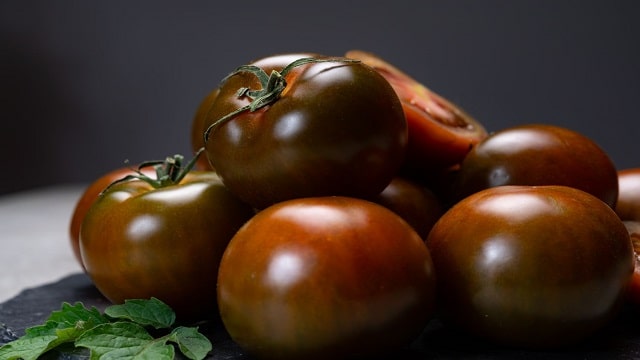
More than just a variety, the Kumato tomato is a brand of its own. Developed and registered by Syngenta, this version was created with the aim of creating a type of tomato capable of producing more and with greater firmness. Its dark colour has both fans and detractors, or rather, palates that are not entirely impressed with the result. In general, its flavour is classified among the sweetest tomatoes and it is considered ideal for recreating classic recipes.
Canary tomato
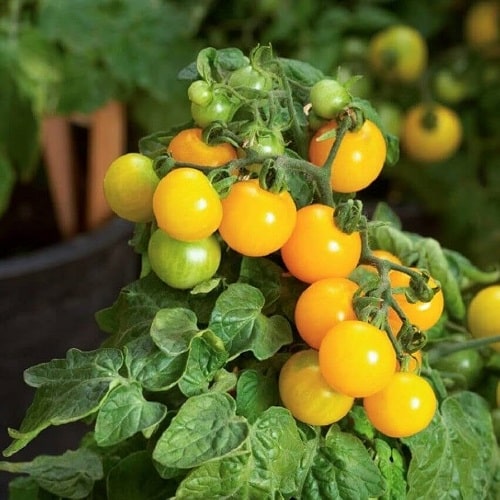
The Canary tomato is a variety that comes directly from the Aztec civilization. In fact, according to naval voyages, the Canary Islands could have been the first to receive the fruit on this side of the Atlantic. Its shape is rounded, smooth, without grooves and shiny and it is the most common in supermarkets. Due to its firmness, it can be kept well for long periods of time and can be ideal for oven preparations, although for convenience it is also common to find it in raw preparations.
Tomato bond
Bond tomatoes are large, juicy, have a very thick skin and a uniformly reddish colour. This type of crop does not tolerate cold temperatures but grows easily in greenhouses. They come from a hybridisation that increased their production and are used in the kitchen in the same way as the Canary tomato.
Nutritional value of tomato
The nutritional value of fresh tomatoes is characterized by being low in calories, rich in carotenes, and with a good supply of vitamins, in addition to having a high percentage of water and containing minerals such as calcium and potassium:
- Energy: 19 kcal
- Water: 94 g
- Carbohydrates: 3.5 g
- Proteins: 1 g
- Fats: 0.11 g
- Dietary fiber: 1.4 g
- Folic acid: 28 µg
- Vitamin C: 26 mg
- Vitamin A : (retinol) 94 µg
- Vitamin E: 1.2 mg
- Vitamin B6 : 0.11 mg
- Niacin: 0.80 mg
- Carotenes: 494 µg
- Iron: 0.6 mg
- Calcium: 11 mg
- Iodine: 7 µg
- Magnesium: 10 mg
- Zinc: 0.22 mg
- Potassium: 290 mg
- Phosphorus: 27 mg
Properties and benefits of tomatoes
Tomatoes are an ally of low-calorie diets, they contain B vitamins, and vitamin C and are rich in antioxidants. They also contain phytosterols that partially inhibit the absorption of cholesterol in the intestine. They are cardioprotective, take care of our visual health and their consumption is related to lower mortality, as is the case with fruits and vegetables.
Take care of your skin
The antioxidant and carotene content of tomatoes has an anti-aging effect by defending the body from oxidative stress. Lycopene in particular acts as protection against damage caused by solar radiation on the skin.
Protect your eyesight
Vitamin A, together with lutein and beta-carotene present in tomatoes, improves our vision, prevents macular degeneration, and prevents vision loss and the appearance of cataracts, thus contributing to good eye health. Beta-carotene, on the other hand, is a precursor of vitamin A, which helps regulate light and is essential for night vision.
It is cardioprotective
Tomatoes protect against cardiovascular diseases thanks to the action of lycopene, vitamin C, and folic acid. Together they contribute to the proper absorption of iron and prevent the accumulation of fat in the arteries, which makes tomatoes a cardioprotective fruit.
Avoid constipation
Dietary fiber, found mainly in tomato skin, is associated with a lower incidence of chronic intestinal disorders and constipation. Fiber also plays an antioxidant role, is associated with lower cholesterol levels, and helps control blood sugar levels.
Diuretic
Tomatoes are a diuretic food par excellence due to their high water content and low sodium content. This nutritional profile contributes substantially to the elimination of liquids and is an indisputable ally in reducing the fluid retention that causes cellulite and orange peel skin.
Antioxidant
The content of vitamins, polyphenols, and carotenes makes tomatoes an antioxidant bomb associated with anti-aging, cardioprotective effects, and preventive action against certain types of cancer. For example, lycopene has been one of the most studied carotenes with antioxidant effect for the prevention of prostate cancer.
Contraindications of tomatoes
Patients with gout should avoid eating tomatoes as they increase the amount of uric acid in the blood. However, specialists clarify that eating this fruit is not in any case the primary cause of developing gout. Beyond this consideration, it is advisable to keep in mind that tomatoes are an acidic food and can therefore cause discomfort in mouth wounds.
How to eat tomatoes: recipes and uses in the kitchen
The first step to enjoying tomatoes is to choose those with a more penetrating aroma, turgid, but not hard, with soft skin and a bright color. This type of tomato will do wonders with our caprese salad, in the salad with avocado and something firmer will be the perfect excuse for some stuffed tomatoes baked in the oven.
If you choose the ripest ones, you can try preparing your own homemade tomato sauce. And if you get a good amount of pear tomatoes, you can explore the differences between salmorejo and gazpacho or jump straight to the lesson on tarte tatin with cherry tomatoes. In any of their forms, some tomatoes safely stored in our greengrocer’s cupboard can give us a great cooking session and healthy dishes.
